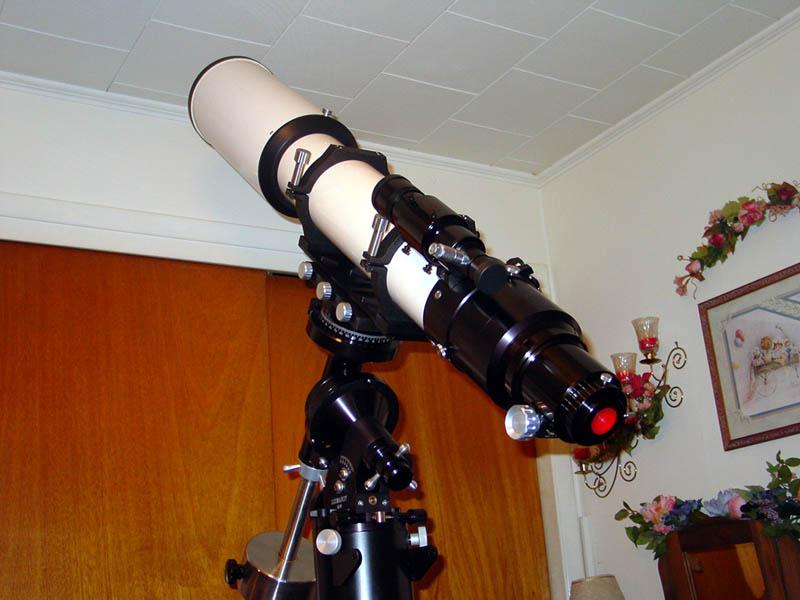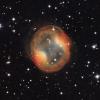
OTA material: Aluminium or Kruppax 50? (thermals)
#1

Posted 31 January 2013 - 03:28 PM
Aluminium is a good conductor while Kruppax 50 is a good insulator. Arising from these differences, I wonder about the following:
- One of the things that attracted me to a doublet is its quick cooldown. Will a Kruppax 50 tube negate much of that, compared to aluminium?
- Dew can be a nuisance in the UK and I've been told Kruppax does a lot better at avoiding dew formation as it doesn't get cold to the touch like aluminium does. Is it likely to make a difference to whether I need to use a dew heater, or anything along those lines?
Since many of APM's OTAs use Kruppax I was wondering if anyone out there has such an OTA and has any anecdotes for how much of a difference they have experienced, while on their own or especially where they could compare with others - for example at star parties where others have Dobs or aluminium OTAs.
I'm not trying to declare one or the other as being flat-out "better" in any childish sense, I'd just like to have as clear as possible an understanding of their differences and how that matters given the UK's climate. I'm satisfied that both are mechanically suitable etc. I know APM doesn't have such a huge presence in the US so I'm not sure whether I am asking in the right forum but I thought I might as well ask because I'm in my usual state of "this vs that" decision deadlock.
#2

Posted 31 January 2013 - 03:40 PM
#3

Posted 31 January 2013 - 04:25 PM
I would go with the Kruppax 50 without a second thought. With the Kruppax tubes 95% of the time I never need to turn on the heating system but I usually have it hooked up just in case.
Harvey
#4

Posted 31 January 2013 - 04:42 PM
https://publicmissil...s.asp?groupid=9
I built a TMB175 around the 7.512" pre-fiberglassed phenolic tube and it was EXCELLENT !!!
http://www.pbase.com.../image/68845494
http://www.pbase.com.../image/68845498
http://www.pbase.com.../image/68845446
#5

Posted 31 January 2013 - 04:44 PM
Phenolic -
* For any rocket 3.0" through 11.4" that will not exceed 0.85 mach.
Fiberglassed Phenolic -
* For any rocket expected to exceed 0.85 mach.
I joke but I just want to point out that these materials (Kruppax/Phenolic) are extremely tough.
#6

Posted 31 January 2013 - 04:59 PM
Thanks everyone for the replies. This might just allow me to make a decision! I'll keep watching the thread for a bit longer though of course.
#7

Posted 31 January 2013 - 05:08 PM
You can see my dewshield is frosty in that pic, that's painted kruppax not-fiberglassed.
I built a few aluminum scopes too. I prefer'd the kruppax/fiberglass tube in every way. It was an exceptionally well behaved scope thermally and dew/frost wise. There was never anything on that objective.
#8

Posted 31 January 2013 - 10:17 PM
Harvey
#9

Posted 01 February 2013 - 09:50 AM
Could you post some more details about this scope? And what was the source for the Kruppax (Public Missles?)? Looks to be all A-P gear behind the dew-shield.
Thanks,
#10

Posted 01 February 2013 - 12:25 PM
That said, thermals in my refractors are never as destructive as they are in my reflectors, for obvious reasons.
#11

Posted 01 February 2013 - 05:08 PM
Is this true?
So what would be ideal material for imaging refractor tube without active cooling(fans), Aluminum, Kruppax or Carbon fibre?
#12

Posted 01 February 2013 - 05:53 PM
Harvey,
Could you post some more details about this scope? And what was the source for the Kruppax (Public Missles?)? Looks to be all A-P gear behind the dew-shield.
Thanks,
More details about the scope can be found here.
http://www.cloudynig...hp?item_id=1282
The Kruppax dew shield was sourced from APM/Markus.
The only AP gear on the optical tube is the focuser. Everything else was designed and built separately.
Harvey
#13

Posted 01 February 2013 - 06:19 PM
So what would be ideal material for imaging refractor tube without active cooling(fans), Aluminum, Kruppax or Carbon fibre?
I don't believe there is an ideal material. Of the ones you mentioned aluminum would come the closest but it isn't going to keep up with the optic's change in focal length as things cool off. You'll have to re-focus with any of them.
Most, if not all, refractor optics have a progressively shorter focal length as the optic cools. Even aluminum doesn't contract at a rate sufficient to keep up with it but it does contract more than the other materials mentioned.
I have no idea how a cooling fan would change any of these characteristics.
Harvey
#14

Posted 01 February 2013 - 06:27 PM
#15

Posted 01 February 2013 - 06:48 PM
A. Wesley cooling techniques
Cooling of a telescope is mainly due to its exposure to the clear sky, which can be extremely cold--on the order of -50C or more. The primary mechanism is radiative cooling. Convective and conductive cooling is limited by the surrounding air temperatures. (Except for Mike who lives in Alaska).
Bare aluminum tubes, especially if polished, have low thermal emissivity, i.e., they are not efficient radiators to the cold sky. But they do conduct heat well and so will tend to closely follow changing air temperatures. Steel tubes have higher emissivity and have a tendency to overcool. This why dew often forms inside an uninsulated steel tube. However, painting both types of tubes modifies the emissivity, and in the case of aluminum, somewhat degrades the otherwise desirable emissivity attributes.
So to finally get to the point, a perfect tube would cool efficiently, but not too much. The best tube is a bare aluminum tube with a thin layer of insulation to reduce any chance of over-cooling by radiation to the cold sky. This is the tube solution that has the lowest thermal mass.
Painted tubes, whether steel or aluminum, must have a sufficient layer of insulation to prevent overchilling, which besides promoting dew formation can also cause tube currents. Such tubes cool less efficiently and have higher thermal mass than the bare aluminum tubes + thin insulation.
Tubes made of thermally insulating material have no real disadvantages versus insulated, painted steel or aluminum tubes, unless the thermal mass is too great. Then it becomes impossible to track ambient temperatures if they are changing too rapidly. Old style, rather thick fiberglass tubes may fall into this category. Lightweight resin-impregnated materials should be fine as long as they are not too thick.
JimC
#16

Posted 01 February 2013 - 06:59 PM
Just wondering,
Rich
#17

Posted 01 February 2013 - 08:10 PM
Best ever: TMB175. Never dewed. Never frosted lens even as you have seen in that pic with frost all over the tube. Generous length Kruppax dewshield with lip, Kruppax fiberglassed tube.
#18

Posted 01 February 2013 - 09:04 PM
That mirrors my experience exactly. At present the AP 130 f/8.35 is the only scope that I absolutely have to use a dew heater with. Everything on it is aluminum and the dew shield is relatively short.
Harvey
#19

Posted 02 February 2013 - 04:30 AM
Worst dewing/frosting telescope I've owned: Tak FS128. Dewed up FAST. characteristics: All aluminum, extremely light, short dewshield with no lip.
Best ever: TMB175. Never dewed. Never frosted lens even as you have seen in that pic with frost all over the tube. Generous length Kruppax dewshield with lip, Kruppax fiberglassed tube.
This doesn't necesseraly have to do with the tube (or dew-cap) material: Merely due to the additional mass of glass and therefore slower cooling, triplets with none or close air-spaces are less prone to dew than relatively thin doublets.
Example: My Vixen F102 fluorite doublet was twice as fast in dewing than my Tak FCT100 triplet, both standing side by side and both having aluminum tubes and dew-caps as well.
OTOH, the doublet's thermal equilibrium was reached twice as fast as well... => Even here, there is no free lunch!
Chris
#20

Posted 02 February 2013 - 12:48 PM
Mark, is there something about the construction of your 107/700 that makes it resist dewing better than other scopes you've had? The tube is spec'd as aluminum; is the dew shield a composite material?
Rich, both the tube and dewcap are in the Kruppax composite material. The thermal properties of the dewcap are such that dewing is virtually non-existent. Part of the story is that the dewcap ends in a rather thick ring which gives the objective something more to 'look at'. But the tube and dewcap material never gets super cold (i.e. not colder than the ambient temperature) and that is the most important factor in my opinion.
#21

Posted 02 February 2013 - 02:40 PM
Currently I can only find this aluminum 107/700 on the APM site:
APM 107/700 w/2.5" focuser
Your scope sounds like a nice combo.
Rich
#22

Posted 02 February 2013 - 03:37 PM
#23

Posted 02 February 2013 - 05:00 PM
Both my refractors have heavy alum. tubes; they make a dull "thunk" when tapped; not tinny but still metallic, I suppose. The tubes get frosty but the lenses haven't ever dewed, though. Eyepieces and Telrads are more problematic, though.
Not exactly a definitive test, I suppose...
Rich
#24

Posted 03 February 2013 - 02:08 PM
Since I'm having the OTA custom-made now (the Kruppax version of the scope is not quite off-the-shelf like the aluminium OTA) I've sent myself into a dither over whether to choose a standard tube length or a shortened one for binoviewing. If anyone wants to slam my naivety the thread is over in the Binoviewers forum
#25

Posted 03 February 2013 - 09:21 PM
http://www.pbase.com.../image/68819908
green = 2" diagonal optical path length
gray = binoviewer path length
purple = light cone


























